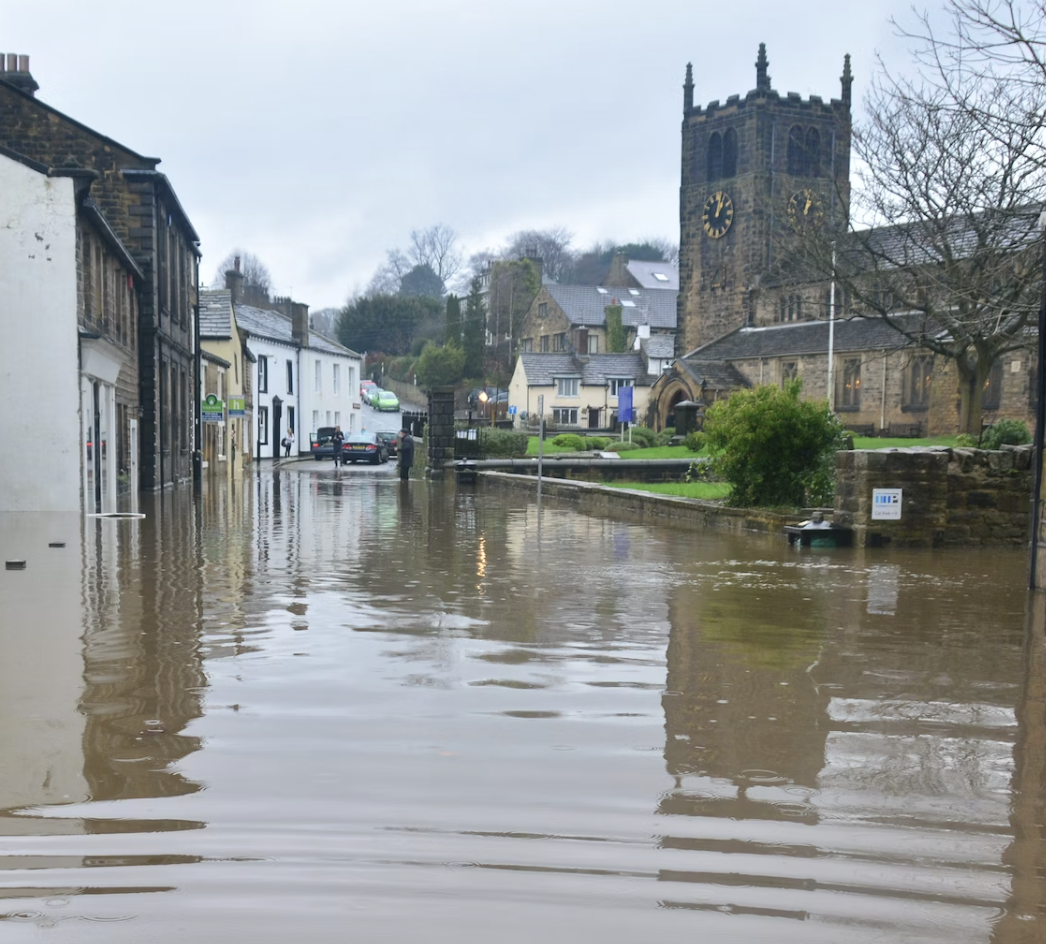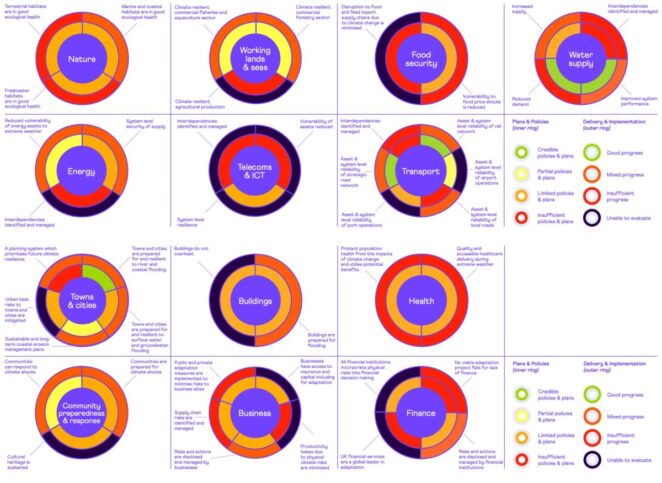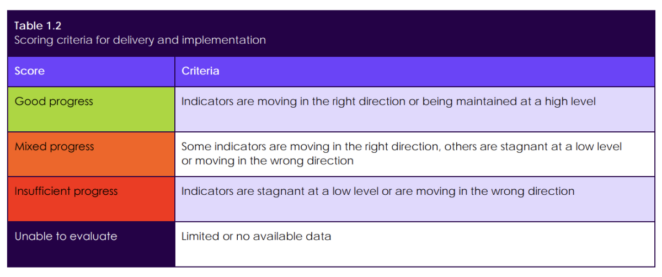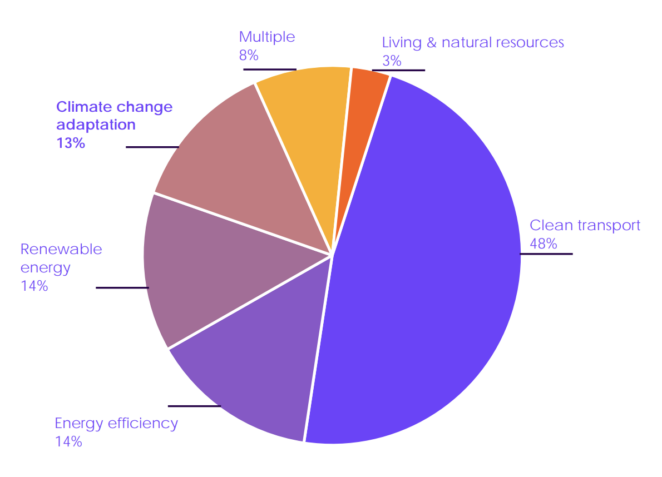Progress in Adapting to Climate Change: 2023 Report to Parliament

Summary
This report provides the Government of the United Kingdom Climate Change Committee’s biennial report of progress in preparing for climate change as required under the Climate Change Act.
It provides an assessment of progress at the end of two National Adaptation Programmes, the statutory programme required from Government to help prepare the country for climate change. The second National Adaptation Programme covered the period of 2018 – 2023 and the third is due to be published in summer 2023.
This weADAPT article is an abridged version of the original text which can be downloaded from the right-hand column. Please access the original text for more detail, research purposes, full references, or to quote text. It has been reproduced under Climate Change Committee copyright 2023.

Key messages
The key messages as outlined by the Climate Change Committee are as follows:
- The second National Adaptation Programme has not adequately prepared the UK for climate change.Our assessment has found very limited evidence of the implementation of adaptation at the scale needed to fully prepare for climate risks facing the UK across cities, communities, infrastructure, economy and ecosystems.
- The impacts from extreme weather in the UK over the last year highlight the urgency of adapting to climate change.The record-breaking temperatures seen in summer 2022 brought unprecedented numbers of heat-related deaths, wildfire incidents and significant infrastructure disruption.
- The next National Adaptation Programme must make a step change. The next National Adaptation Programme (NAP3) must be much more ambitious than its predecessors and lead to a long overdue shift in focus towards the delivery of effective adaptation.
Online launch: Adaptation Progress Report to Parliament 2023
Framing and methodology
This section covers the latest evidence regarding observed global climate change and observed and projected changes in the UK’s weather and climate. It highlights the current evidence regarding which recent trends in weather and climate can be linked to human-induced climate change, and what further changes are expected in the coming decades.
The scope of this progress report is adaptation policy for which the UK Government is responsible. For reserved areas of policy, the progress on adaptation across the UK is assessed; for devolved areas of policy, progress on adaptation is assessed only for England. Northern Ireland, Scotland and Wales produce their own national adaptation plans, on which the Committee provides separate advice and assessment of progress when requested.
Adaptation areas
This report assesses progress in preparing for climate change across thirteen chapters. Each focuses on a specific part of the adaptation challenge, for which climate change poses one or many risks and opportunities which require proactive preparation today. These chapters are structured around assets or systems impacted by climate risk.
- Nature (Chapter 2, p. 52)
- Working land and seas (Chapter 3, p. 77)
- Food security (Chapter 4, p. 96)
- Water supply (Chapter 5, p. 113)
- Energy (Chapter 6, 132)
- Telecoms & ICT (Chapter 7, p. 151)
- Transport (Chapter 8, p. 165)
- Towns and cities (Chapter 9, p. 187)
- Buildings (Chapter 10, p. 230)
- Health (Chapter 11, p. 254)
- Community preparedness and response (Chapter 12, p. 272)
- Business (Chapter 13, p. 290)
- Finance (Chapter 14, p. 316)
Assessment methodology
Within each chapter the updated assessment framework has the following components:
- A monitoring map, which lays out an indicative high-level goal or vision for what being resilient to climate change in this area might mean and identifies tangible key outcomes that the Committee believes will need to be in place to help deliver this. We also identify a set of enabling factors (which are important to the realisation of the outcomes), policy and planning milestones which need to be in place and contextual factors (things which are largely independent of policy action but will nonetheless affect the ability for the identified adaptation outcomes to be delivered).
- Evaluation of relevant delivery and implementation indicators that we identify for each top-level adaptation outcome identified within the monitoring map. This helps track progress towards the delivery of the identified outcomes and the extent to which key enabling factors are in place. Typically, available indicators only tell a partial story and multiple indicators often need to be considered together to provide an overall picture. We evaluate relevant indicators and assess the extent to which these are moving in the right direction. In many instances there are important data gaps or indicators are not sufficiently up to date to provide a current understanding of trends. We set out a monitoring map for each chapter to structure our assessment around and to evaluate progress against.
- An assessment of progress against policy and planning requirements described in the monitoring map. We document recent developments in relevant policies and plans and assess to what extent the relevant policy milestones identified on the monitoring maps are in place, to what extent they are appropriately ambitious, and whether there is appropriate monitoring and evaluation to allow them to function effectively.
Scoring
Within this report we score progress in preparing for climate change at the level of the identified key outcomes within each chapter. For each outcome we identify two summary scores, one for ‘Delivery and implementation’ and one for ‘Policies and plans’. This allows us to distinguish important policy developments that help put in place or strengthen the key identified policy milestones within the monitoring map, and evidence that adaptation outcomes are being delivered on the ground.

Recommendations
Targeted recommendations on further policy actions that are required within each adaptation area to close gaps are provided in the relevant chapters of this report and in a separate document published alongside. We identify owners for these recommendations within Government and implementing agencies and timelines by which they need to be delivered.
Addressing interdependencies
The assessment within this report is conducted separately for each chapter. However, there are a complex set of dependencies between different areas and systems that mean that climate impacts in one system can cascade and interact with others.
These interdependencies can enable climate risks to interact, cascade and compound spatially, temporally and across sectors. By identifying these pathways of interdependency, climate risks can be assessed and mitigated as much as possible. Despite their importance, analysis and evaluation of interdependencies and climate risks are often the most challenging areas for organisations and policy. Most analysis of interdependencies as part of adaptation planning is currently limited to infrastructure interdependencies in some sectors.
The Adaptation Progress Report (ARP) demonstrates that climate risks from interdependencies (risks that arise from an organisation’s reliance on another organisation or sector) are currently not being consistently incorporated into risk assessments or adaptation plans. There is some evidence of cross-sector engagement to address interdependencies, but coordination is needed to enable reporting organisations to identify more clearly, and measure and manage these risks better. Gaps in submissions to the ARP (20% of invited organisations did not submit a report to ARP3) in many sectors prevents other sectors, organisations and Government from gaining an understanding of risks to their organisations and the UK population that result from infrastructure interdependencies. This hinders the role of ARP as a driver for more action and collaboration on adaptation.
Our assessment identified a number of barriers to identifying and managing interdependencies across reporting organisations:
- Lack of understanding of climate impacts in sectors they depend on for their own operations and the complexity of interactions.
- Inconsistencies across sectors in measuring and reporting on climate risks e.g. different risk criteria and different climate scenarios.
- Incomplete data, or concerns about sharing data.
- Regulatory barriers or disincentives.
- Lack of funding, misalignment of funding cycles or research priorities.
- Lack of top-down leadership.
- Limited mechanisms or opportunities for cross sector engagement
Assessment findings and recommendations
Assessment findings:
Consistent with our previous assessments of the NAP2 period, this report finds that no sectors are yet well adapted to the risks of climate change. While some – often quite basic – consideration of climate change within relevant plans is becoming more prevalent, evidence of tangible progress in reducing exposure and vulnerability to climate change is lacking across the board.
- Delivery and implementation: For no outcome have we been able to conclude that there is sufficient evidence that reductions in climate exposure and vulnerability are happening at rates needed to appropriately manage risk. For around one-quarter of outcomes available indicators show insufficient evidence of progress.
- Policies and plans: The provision of key policy milestones and integration of adaptation within relevant sector plans is slowly increasing over time. Most areas now have at least some consideration of adaptation within relevant strategies and plans. However, fully credible planning for climate change – with nearly all required policy milestones in place – is only found for five adaptation outcomes out of the 45 examined in this report. The absence of relevant robust data remains a key barrier to assessing all aspects relevant to delivery and implementation of adaptation policy. There are a large range of risks from climate change to the UK, and a small number of opportunities. In this report we have updated our monitoring framework for adaptation progress to increase the focus on tangible outcomes needed for climate resilience. Adaptation planning is increasingly prevalent but there is limited evidence of it being effective in reducing climate risks. Effective data monitoring for adaptation remains a key barrier in many sectors.
For nearly 40% of adaptation outcomes, the lack of relevant and up-to-date indicator datasets prevents us making an overall judgement on progress in adaptation delivery and implementation. Datasets to evaluate elements of resilience either do not exist, or where they do exist, are not up to date, are not sufficiently comprehensive in scope or only provide a point-in-time snapshot preventing trends being identified in aspects of climate vulnerability and exposure. An effective climate change adaptation monitoring and evaluation programme, with sufficient long-term funding, is a prerequisite to address this and must be introduced with urgency.
In each chapter of this report, we provide a set of specific recommendations for policy actions that can help put into place additional pieces of the policy landscape necessary to deliver adaptation outcomes, with a clear owner in Government identified.
Highest priority recommendations:
Highest priority recommendations for Government to address over the next two years are:
- Nature: Set interim adaptation targets to drive early action to improve climate resilience of nature, enable progress assessments, and secure adequate resources (including for green jobs and skills) to facilitate delivery of the targets.
- Working land and seas: The Land Use Framework should address the trade-offs and co-benefits of multifunctional landscapes to benefit climate mitigation, adaptation, food security, nature recovery, forestry, fisheries, recreation and rural livelihoods.
- Food security: Extend the scope of the fourth round of the Adaptation Reporting Power (ARP4) to include food supply chains.
- Water supply: Ensure sufficient investment, resources and progress monitoring to support delivery against demand reduction and leakage targets, given the significant gap between targets and progress.
- Energy: Designate Ofgem and parties responsible now and in the future (including the new Future System Operator) for the maintenance of energy sector codes and standards, with a clear mandate to ensure climate and weather resilience.
- Telecoms and ICT: Develop a set of indicators to enable monitoring of the impacts of weather and climate on telecoms and ICT services and the actions being taken to manage them, and designate Ofcom with a statutory remit for climate resilience.
- Transport: Extend the scope of the next round of the Adaptation Reporting Power (ARP4) to cover local authority functions related to road infrastructure, ports, airports, and key supply chain organisations.
- Towns and cities: Planning policy reform should ensure that climate resilience is a priority, with mandatory adaptation interventions on all built environment project applications.
- Buildings: Expand the Part O Building Regulation requirement to cover refurbishments of existing buildings, conversions of non-domestic buildings to residential, and prisons.
- Community preparedness and response: Include community engagement activities (such as citizens assemblies) under NAP3 to put fairness at the centre of efforts to implement a vision for a well-adapted UK. This engagement programme should focus on exploring issues of fairness in some of the most challenging aspects of adaptation (e.g. coastal retreat) and in the provision of public funding for adaptation.
- Health: Work across Government and with local authorities to develop a long-term cross-sector approach to address risks in the social care sector, including using appropriate levers to accelerate adaptation action, and ensuring that monitoring of overheating occurrences and air quality in care homes is undertaken frequently.
- Business: Strengthen adaptation reporting requirements across the Sustainability Disclosure regime and build on the work of the Transition Pathways Taskforce (on Net Zero-related corporate transition plans) to define common standards for what a high-quality adaptation transition plan should look like. This should include how relevant physical climate risks are measured and managed and how plans would contribute to wider societal adaptation to climate change.

- Finance: The refresh of the Green Finance Strategy in 2023, together with NAP3, should clarify where the Government expects adaptation actions to be funded through public sources and where private investment is expected. NAP3 should contain clear new funding commitments for investment in adaptation over the coming five-year period and the breakdown across department budgets.
- Interdependencies: Set out, in NAP3, a national plan for managing interdependency risks, including clear and consistent responsibilities for climate resilience across sectors and mechanisms for cross-Government collaboration.
Suggested Citation:
Freeman B., Gardiner A., Holmes G., Kennedy M., Labuschagne C., Shears O., Sherman S., Style D., Douglas C., Parker C. and Millar R. (eds), (2023), Progress in adapting to climate change 2023 Report to Parliament, Climate Change Committee, UK Government, United Kingdom, ISBN: 978-1-5286-3943-9
Related resources
- Progress in reducing emissions 2022 Report to Parliament
- Independent Assessment of UK Climate Risk Advice to Government For the UK’s third Climate Change Risk Assessment (CCRA3)
- Q&A: Francis X. Johnson on the IPCC Synthesis Report
- Resilience and Green recovery in Europe: the critical role of the EU Adaptation Strategy
- Towards a Global Adaptation Progress Tracker: first thoughts
- Progress and Challenges in Achieving Vertical Integration in Adaptation Processes
- Progress and Challenges in Urban Climate Adaptation Planning - A Global Survey
(0) Comments
There is no content